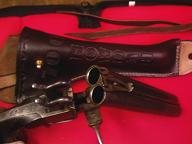

 The Accurate Reloading Forums
The Accurate Reloading Forums  THE ACCURATE RELOADING.COM FORUMS
THE ACCURATE RELOADING.COM FORUMS  Rifles
Rifles  Big Bores
Big Bores  Pressure of NE rounds?
Pressure of NE rounds?Go  | New  | Find  | Notify  | Tools  | Reply  |  |
one of us |
Hello, does anyone have a reference to the Sammi pressure specs of the various NE rounds? 470, 450 no2, 500. I can't seem to find them in any of my books. Thanks. | ||
|
| one of us |
kyoch's website has pressure listings. Try this: http://freespace.virgin.net/kynoch.ammunition/list%204.htm Bob | |||
|
one of us |
looks great. Now for the conversion from tons per square inch. I'm assuming mulitpy by 2000? The 458 Lott shows 18.5 tons which would be 37Kpsi. Sounds a little low to me. Is the *2000 right? Can the 450x400 be used on dangerous game like Cape Buffalo? newbie at work.... | |||
|
| one of us |
quote:Bob, that's a really strange set of numbers on some of those cartridges. Look at ft lb energy at the muzzle and again at 100 yds comparing the 450 NE and the 450 NE #2. Both with the same bullets, the #2 starts out faster and hence more muzzle energy but by 100 yds has about 10% less energy than the slower 450 NE. Some strange physics for sure. Brent | |||
|
| <Axel> |
LAR45, Kynoch uses imperial, or long tons. These equate to 2240 pounds. So 18.5 tons per square inch would convert to 41440 psi. Axel | ||
|
| one of us |
The 450Ne 3.25" developes 17.0 tons ( 17.0 X 2240 LT = 38,080 cup ), and the 450#2NE developes 13.50 tons ( 13.70 X 2240 = 30688 cup) , or 7392 lbs cup less chamber pressure,while developeing 5037 fpe, as opposed to 4909 for the 450NE 3.25" Basicly the same numbers,for both, with the edge going to the 450#2 NE because of less chamber pressure, an effect of the very large case capacity of the 450#2 ( the case being 4" long, and bottelnecked from a 500NE head size). Neither you nor the buffalo will know the difference between these two rounds, but your rifle will! [ 04-03-2003, 22:21: Message edited by: MacD37 ] | |||
|
| one of us |
quote:This URL is probably easier to remember: http://www.kynochammunition.co.uk/ Just FYI. -Bob F. | |||
|
one of us |
Lar45, According to Graeme Wright in Shooting The British Double Rifle, the original pressure measurements were taken at the base of the case with the copper crusher method in tons per square inch (TPSI), and the pounds per square inch (PSI) measurements were generally taken with side-wall piezoelectric transducer or copper crusher. He feels that there is not a direct conversion to PSI from TPSI that is applicable here, but the new Kynamco (Kynoch) seems to have tried to develop a compatible conversion formula. I, too, would love to have a general guideline for this conversion, as I am working with several doubles in calibers that have very little published loading data. Maybe some of our advanced internal ballisticians can come up with an approximate conversion formula, but I suspect that it will be not be as easy as multiplying 2240 times TPSI to convert to PSI (it would be nice if it was this easy however Jim | |||
|
| One of Us |
Something to perhaps remember with the big Nitro rounds is that although the case capacity is very large the original powder charges were quite small. Over my reloading life I have done lots of loading with reduced loads, although many of these have been at higher pressure. If for example you play about with calibres like the 300 Winchester etc. and work up full loads with powders like 3031 burn rate, then you don't end up duplicating 30/06 velocities with lower pressures. You only get low pressure loadings that duplicate 30/06 ballistics when you back of the loads with powders that are in the 4350/4831 burn rate areas. Of course the average pressure will be the same but the larger powder charge allows fora lower peak pressure so as to have the same average pressure. I have read a fwew times (don't know if it is true) that cordite will give a higher velocity fora given peak pressure and powder weight than is the case with our stick powders. Mike | |||
|
| Powered by Social Strata |
| Please Wait. Your request is being processed... |
|
 The Accurate Reloading Forums
The Accurate Reloading Forums  THE ACCURATE RELOADING.COM FORUMS
THE ACCURATE RELOADING.COM FORUMS  Rifles
Rifles  Big Bores
Big Bores  Pressure of NE rounds?
Pressure of NE rounds?

Visit our on-line store for AR Memorabilia

